Apistogramma sp. "D21" has been re-collected.
December 2020

When the Apistogramma sp. "D21" was collected for the second time, in 2017, it amazed us with it's colorful ventral fins.

Now this species has been collected again, and this years specimens seem to be just as colorful as the 2017 - specimens:
xxxxxxxx
Apistogramma sp. "D62" has been collected.
November 2020
The colorful and interesting A. sp. "D62" were collected for the second time just a few weeks ago, in Colombia.
As the fish has not arrived here yet, I have no own photos to present. However, a few fishes were sent to Japan immediatley after
collecting. There Yukitoshi Ohnota photographed them, which resulted in some amazing photos of this new species.
I'm very happy that Mr. Ohnota gave me permission to publish some of his photos here:




xxxxxxxx
The Colombia tour December 2019
The December tour in Colombia gave us lots of rain and high water levels, but also some beautiful Apistogramma - locations


and some interesting species. Here I present some of them:
Apistogramma sp. "D60"
May 2020
We found what we, at several locations, believed was one species, and labelled them all Apistogramma. sp. "D60".
Back home, the fishes from the different locations all appeared Apistogramma bitaeniata-like, but they have a separate caudal spot,
and they seem to represent at least two different forms:

xxx
Apistogramma sp. "D61"
May 2020
We also found a fish quite similar to the A. sp. "D60" - forms, but it shows some very interesting ventral (pelvic) fins!
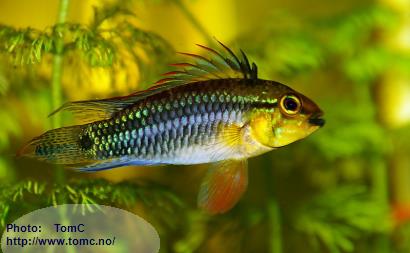

>
xxx
Apistogramma sp. "D59"
December 2019
We only found two specimens of the A. sp. "D59"!
Here at the location, and the male in an aquarium:


>
xxx
Apistogramma sp. "D58"
December 2019
The colorful A. sp. "D58" shows similarities with the A. sp. "D56", but was collected far away from that species.
Here just after collection, and wild males in aquariums:


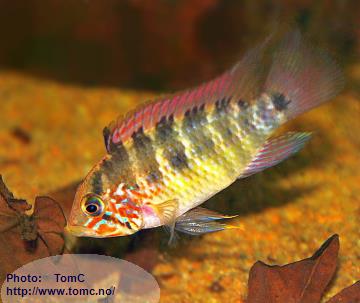
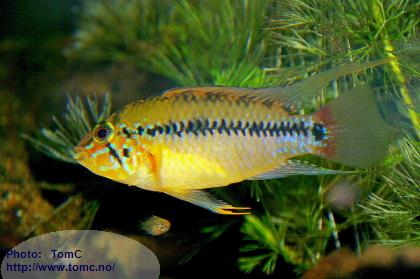
xxxxxxxx
Apistogramma sp. "Putzer/Cleaner" from the Río Negro, Colombia
July 2019


These fishes might be observed repeatedly “dancing” around the head of a larger fish,
then swimming laterally along the body, and at the same time carrying out picking motions, both
toward the gill covers as well as the sides of the body. The larger fish will remain in its position
and allow the “examination”. I have observed this myself.
The conclusion is that during the procedure parasites are picked off of the skin of the larger fish.
(If the scales had been bitten, the larger fish would have reacted differently.)
Similar behavior is well known in marine cleaner fishes.
Because of this specialized behavior, the species was called “Putzer/Cleaner-Apistogramma” by
Koslowski (2002).
The described behavior probably developed because it expands the nutrient resources of fishes from
the nutrient poor Rio Negro. It is of benefit to the fish when compared to those that do not show
this behavior.
The Apistogramma sp. “Putzer/Cleaner” was second reported from São Gabriel, Rio Negro, Brazil.
The specimens shown here, however, were collected in the Colombian part of the Río Negro, so there is
some uncertainty about the exact identity.
xxxxxxxx
Apistogramma cf. flabellicauda from the Río Negro, Colombia)
July 2019


These fishes show most of the characteristics typical for Apistogramma flabellicauda.
In the scientific description the distribution of Apistogramma flabellicauda is said to be
"bajo y medio río Ventuari, alto Orinoco antes de confluencia con el río Ventuari y río Autana".
(Lower and middle Ventuari river, Alto Orinoco river before confluence with the Ventuari river and
the Autana river)
The speciemens presented here, were collected in the Colombian part of the Río Negro, i.e.
quite a distance away from the type locality, and in a different watercourse.
That is the reason for the "cf.".
They spawned immediately after arrival in my tank, even though a group of fishes were put together.
xxxxxxxx
The fish formerly known as Apistogramma cf. diplotaenia "Orinoco"
has been scientifically described, as Apistogramma psammophila
February 2019


A few of them have also found their way into one of my tanks here (May 2019).
You'll find the complete description here:
Apistogramma psammophila – a new geophagine dwarf cichlid (Teleostei: Cichlidae)
from the Rio Atabapo drainage in Colombia and Venezuela.
Wolfgang Staeck & Ingo Schindler
xxxxxxxx
The Colombia tour December 2018
The December tour in Colombia gave us at least four presumably new species:
Apistogramma sp. "D53"
December 2018
The A. sp. "D53", shows some similarities with the A. sp. "D6"
(= A. sp. "Mitu").
A few photos shot at the location:

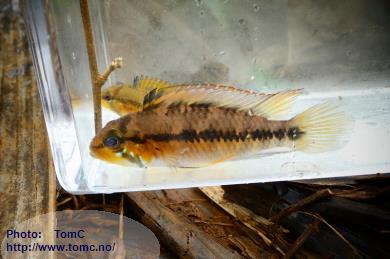


>
xxx
Apistogramma sp. "D54"
December 2018
The A. sp. "D54", shows a sooty area on the abdomen when excited, and a
colorful "face". Here just after collection:




xxx
Apistogramma sp. "D55"
December 2018
The A. sp. "D55" shows a dark "V" on the gil cover that could remind of the A. sp. "D37". A few shots just after collection:




xxx
Apistogramma sp. "D56"
December 2018
The A. sp. "D56", shows some remarkable colors on the head.
Here are a few photos shot at the location just after collection:




xxxxxxxx
Apistogramma cf. hoignei from Colombia
October 2018
Most Apistogramma (cf.) hoignei are reported (and described) from Venezuela.
This form came from the Puerto Carreño area in Colombia. Of course it can not be excluded that they
were collected in Venezuela and brought over the border.
The male's head and breast are predominated by yellow tones, and the typical black outer seam in the caudal fin here is mostly shown in the lower part of the fin:

The female has fry now, and she shows interesting black markings on the chin, throat and breast:


xxxxxxxx
The Apistogramma sp. "D37" has been found in two new locations
May 2018
We collected the Apistogramma sp. "D37" in February 2017, in headwaters of the Río Inirida.
They were presented here earlier (April 2017).
Recently this species has been found and collected in two new locations, both draining to headwaters
of the Río Vaupes.
The second one was given the nickname "A. sp. "D37" (Mega-purple) by a well known German
Apistogramma-enthusiast.
And with good reason; it really shows purple color in my tank:


>
Specimens from the other location show a lot of yellow, and the German enthusiast called them
A. sp. "D37" (Hyper-yellow).
Again with good reason:


xxxxxxxx
The Apistogramma sp. "D6"
May 2018
Some time ago, we believed that the now Apistogramma sp. "Rautenband" (see below) is the same
species as the
A. sp. "Mitú" [A 109]. To make it short: It's not.
At the same time, I was chasing a fish that seemed to be a ghost;
I saw photos and heard it was collected, but every attempt to get it from Colombia, failed.
We labelled the slender fish Apistogramma sp. "D6".
This fish is most likely the true Apistogramma sp. "Mitú" [A 109].
AND IT'S FINALLY HERE! :-)


xxxxxxxx
The Apistogramma sp. "D18" has arrived
May 2018
The fish we gave the preliminary name Apistogramma sp. "D18" has proved to
most likely be identical with
the A. cf. alacrina (Guayas) [A 108].
It looks like this, in one of my tanks:


There also exists a fish we have given the preliminary name
Apistogramma sp. "D18b". This form usually shows less/different colors,
and the spots (in the rows of spots) are orange and black. It is found in a different location
than the "D18".
I don't have any own photos of it, and no permission to publish other's
photos.
xxxxxxxx
And yet another new Apistogramma from Colombia
March 2018
Apistogramma sp. "D52" is definitely something completly new, and was
collected in the eastern part of the country this month.


xxxxxxxx
Another exciting Apistogramma from Colombia
March 2018
Apistogramma sp. "D51" seems to be a member of the A.-iniridae-Group.
It has similarities with both A. cf. iniridae [A 160] and the A. sp. "Içana" [A 161],
but doesn't quite match any of them.
It is probably another new species...
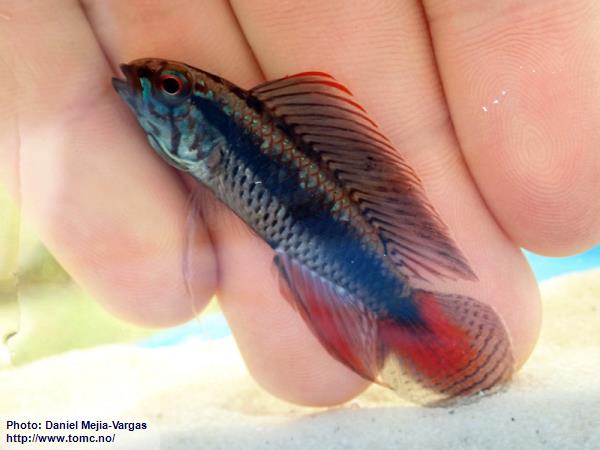
xxxxxxxx
Apistogramma sp. "Rautenband" is the new, preliminary name
for Apistogramma sp.
aff. "Mitú"
February 2018
Frank Hättich and Uwe Römer have published the article:
Apistogramma sp. „Rautenband“ – Ein aquaristisch neuer Zwergbuntbarsch aus dem
Einzug des Río Vaupés
DCG-Informationen
Die Zeitschrift der Deutschen Cichliden-Gesellschaft e.V.
49. Jahrgang, Nr. 2, Februar 2018

(The name "Rautenband" means "Diamond band" and refers to a pattern of diamonds (rhombi) often formed
by the lateral band and additional dark scale-edges in the area of vertical bars 5-7.)
A couple of my fishes:


xxxxxxxx